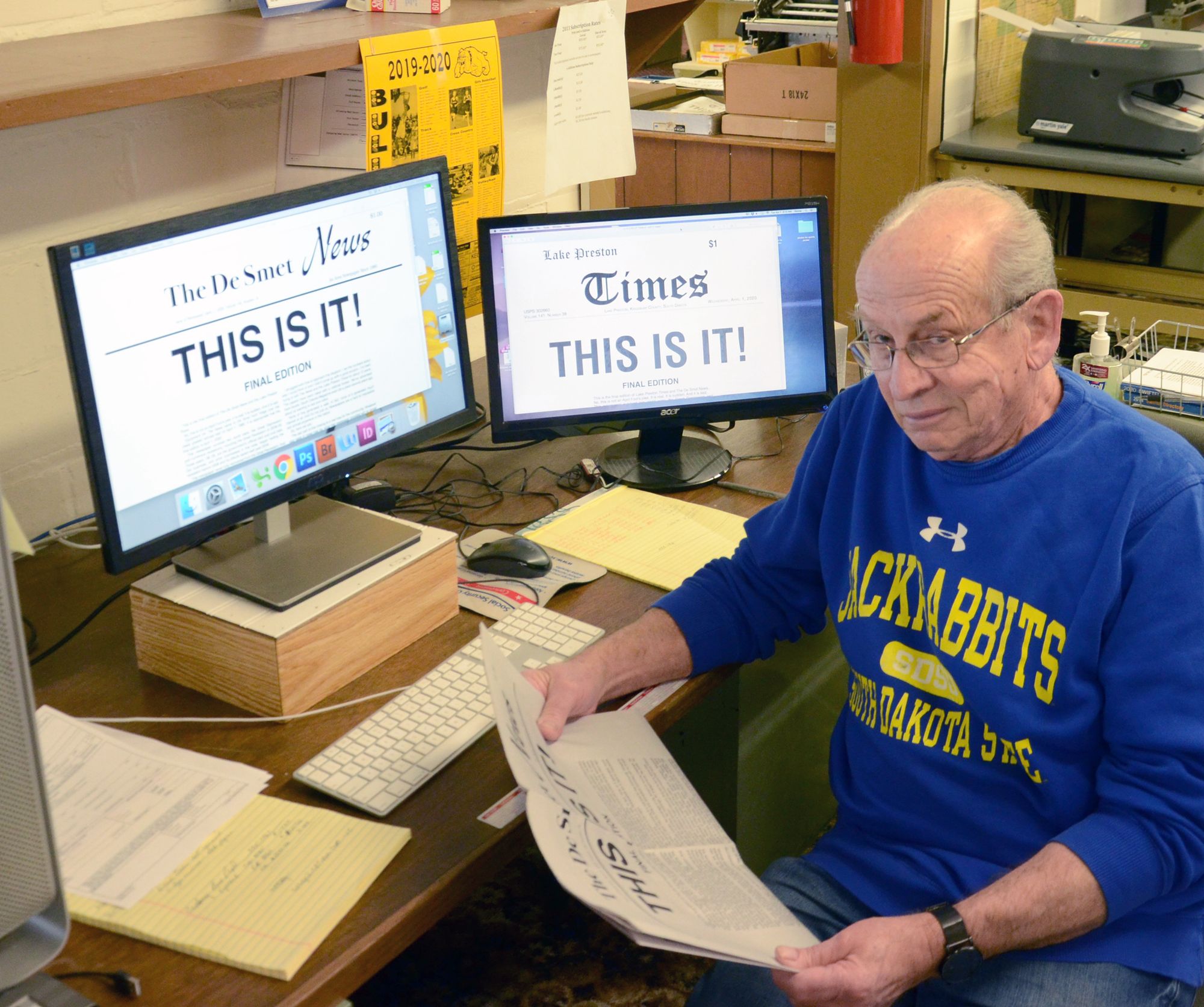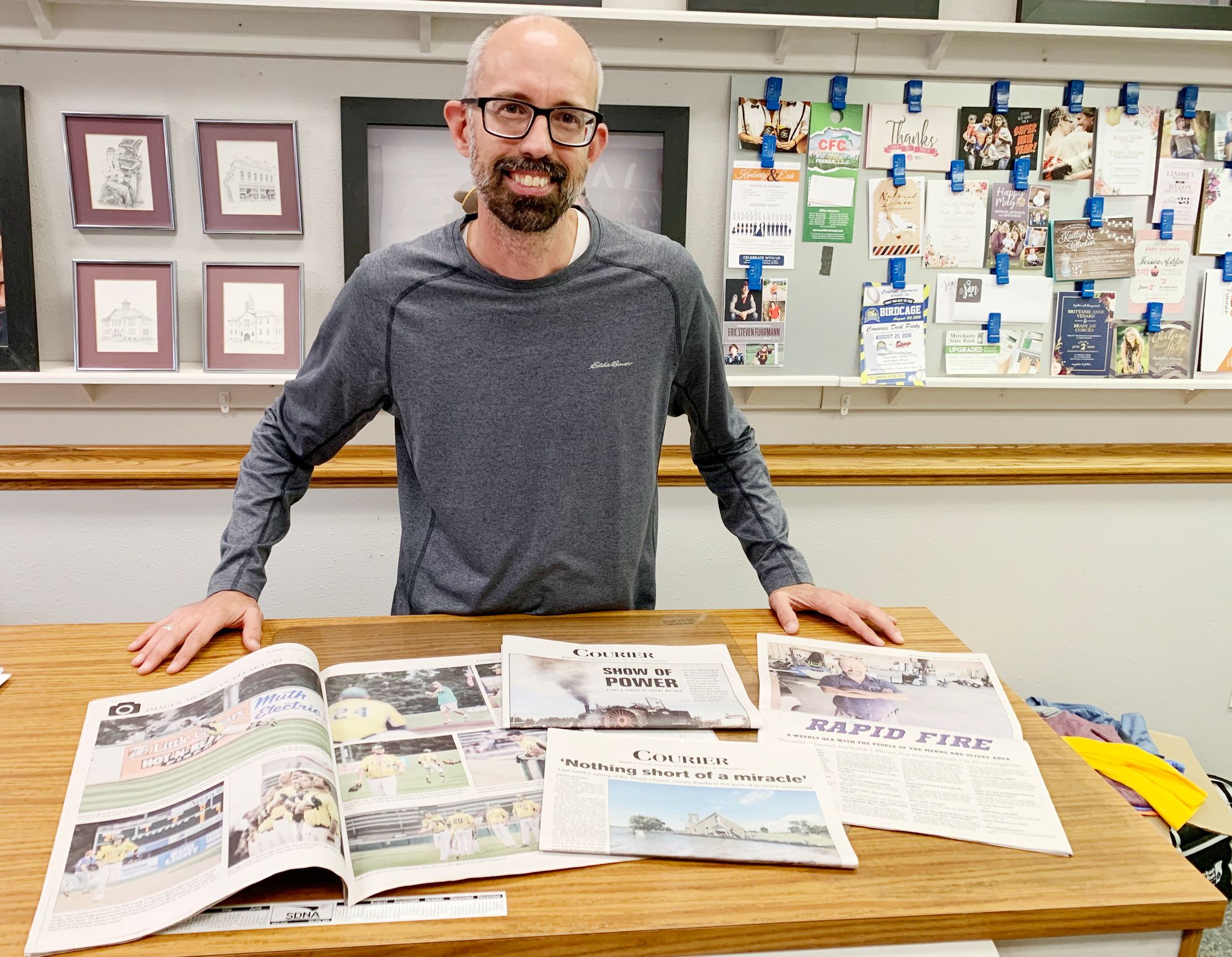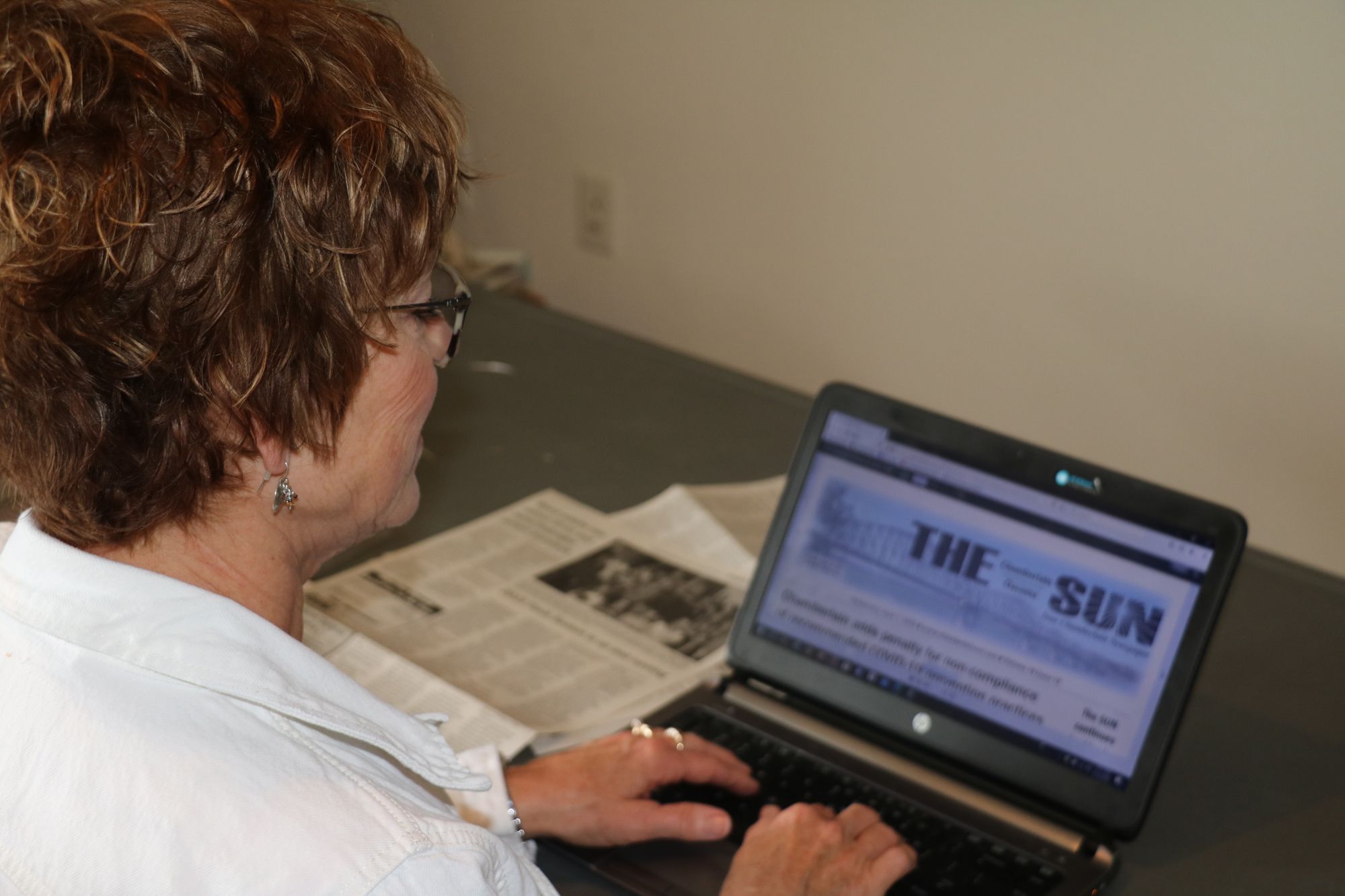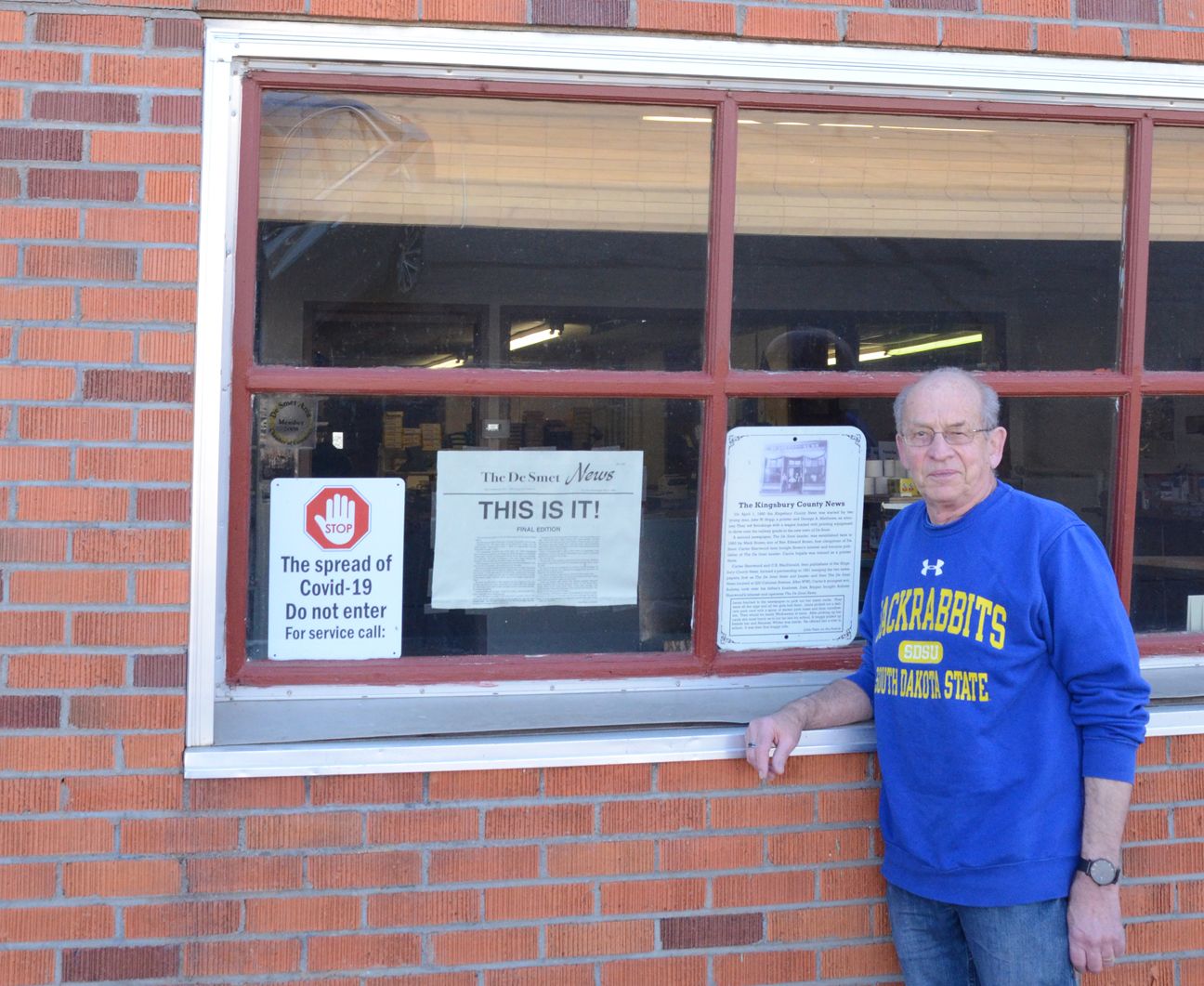As the COVID-19 pandemic upends the South Dakota economy, leading to temporary business closures and skyrocketing unemployment, one of the state’s most venerable, trusted and beloved institutions is falling victim to the financial free fall: the small-town weekly newspaper.
The recent reductions in circulation and advertising caused by the deadly virus and fear of spreading it have added a new layer of economic hardship to weekly newspaper publishers who were already seeing significant and historic declines in business revenues, staffing, news pages and personal incomes.
The level of risk and potential for finality were borne out on April 1, when the owner of two weekly newspapers in northeastern South Dakota — The De Smet News and the Lake Preston Times — made the painful decision to cease publication of the papers that had been printed for nearly 140 years.
All newspapers, including dailies and weeklies, have suffered in recent years from loss of readership and advertising resulting from fundamental changes in how people consume and pay for news.
The emergence of mostly free news on the internet, the shift of classified advertising to websites, and a reduction of readership of printed newspapers by young people have all led to reduced circulation and declining interest among businesses to advertise in newspapers.
Papers like the Rapid City Journal, Pierre Capital Journal and The Huron Daily Plainsman have reduced the number of days they publish each week. Employees at the daily papers in Rapid City, Aberdeen and Sioux Falls have undergone mandatory unpaid work furloughs. And many weekly papers have been forced to cut back on pages per issue, end publication of special sections or keep open positions unfilled.
Dale Blegen, owner and publisher of The De Smet News for the past 43 years and of the Lake Preston Times for the past 36, said the loss of revenues tied to the COVID-19 pandemic was the last financial straw that led him to shutter his newspapers. With a stark, perhaps slightly bitter headline declaring, “THIS IS IT! FINAL EDITION,” Blegen informed his readers on April 1 that the end of the two papers was nigh, including in De Smet, a popular tourism town of about 1,100 people that is famous as the home of author Laura Ingalls Wilder.
“With the internet, Facebook, Craigslist, the local development agency running job ads, and then the COVID-19 shutdown, all of it just added up,” Blegen said. “When I really got to looking at where we were at financially, I said, ‘Boy, we’re in dire straits,’ and at age 76, I didn’t want to retire and go into debt.”

Papers play a big role in small communities
Like any business in a small town, where services are few and options limited, newspapers play a key, singular role in a community. In burgs with only one grocery store, one hardware store and one gas station, weekly newspapers are typically the only source for information on what to buy and where to buy it, on actions (or inactions) of town councils and school boards, on crimes and resulting punishments, on youth sports, on agriculture and industry, on the lives and deaths of community members.
To a great degree, weekly newspapers tie the residents of a small town together and also provide a traceable history of life in the communities they serve. It is a role no other institution can fully replicate. They also provide the critical role of overseeing government agencies and institutions and watching out for how taxpayer money is spent. Losing a newspaper eliminates in what in many small towns is the only check on government operations and the actions of elected officials.
“A newspaper is as important to a community as a school or bank or any other institution people look at as ‘ours,’” Blegen said. “It’s part of a community’s identity, and to lose the identity, to lose the history that’s recorded in no other way, is a real loss. I feel badly about that, and I don’t think it’s healthy, but I don’t have a solution to it either.”
The pandemic has forced difficult choices among those who have devoted their careers, and their lives, to community journalism, a vocation that is both a business and a calling. Weekly reporters, editors and publishers often work late into the evenings and on weekends to cover government meetings, shoot photos of high school sports, or just to get the paper written, edited and off to the printer.
Jeremy Waltner is the second-generation publisher of the Freeman Courier, following in his father Tim’s footsteps in running a weekly paper with strong community ties and a reputation for journalistic excellence.
Waltner said he has awoken on recent nights and can’t get back to sleep owing to financial stress, but also the unease of the pandemic. Waltner worries over the safety of himself and his family of four, over the well-being of his community, and over what he fears is an uncertain future for a newspaper he has grown up with and has grown to love.
“It’s an incredible paradox, because right now newspapers are needed more than they’ve ever been, and are also fighting for their survival in a way they have never fought before,” Waltner said. “It seems backwards, but this is our reality.”
Waltner said his “heart sank” when he heard of the closures in De Smet and Lake Preston, and said he felt terrible for Blegen and the residents of those two communities.
“From April 1, 2020, and possibly to infinity, there will not be a record of what happens in De Smet and Lake Preston,” he said. “That’s the loss, and it’s frightening to think about.”
The closures left Waltner wondering about the stability and future of his own newspaper and what its loss would mean to the Hutchinson County community of 1,300 people.
“A newspaper is permanency; it is the unabashed extensive record of a community,” he said. “If you wipe clean the record of the last 25 or 50 years in Freeman, what does that mean? You can’t even comprehend what that means.”

Newspapers face fixed costs in regard to buildings, personnel, paper and ink, and postage expenses that have been climbing steadily. Meanwhile, revenues are restricted to circulation, advertising, legal notices and small printing and publishing jobs outside the newspaper.
Advertising has long been the most substantial revenue stream, so losses occurring at other businesses because of the pandemic have been particularly painful for newspapers.
The stalled economy is threatening the stability of the Native Sun News Today, among the few South Dakota newspapers that focus almost exclusively on coverage of the state’s large Native American population.
Publisher Tim Giago told News Watch that he had to suspend publication of the printed edition for two consecutive weeks in March for financial reasons, and may publish only sporadically as the pandemic continues.
But Giago, who has more than 40 years’ experience in publishing newspapers, said he and his small crew of committed journalists will continue to fight to keep the paper alive and operating.
“Things are tough with no paper sales or advertising, but we are prepared for the long haul,” Giago said in an email.

“I’m afraid we’re going to see more closures to come; I just think it’s inevitable. Publishers of small-town weeklies say that in the short-term, they will be able to ride it out, but if this economic downturn goes on longer, some newspapers will not be able to survive.” -- Dave Bordewyk, executive director of the South Dakota Newspaper Association
New ‘news deserts’ created by closures
The recent closure of the two weekly papers roughly midway between Brookings and Huron has created what researchers at the University of North Carolina at Chapel Hill have deemed “news deserts,” or areas with no newspaper to cover local issues, businesses, schools and government and community events.
The number of news deserts has been on the rise as newspaper financial fortunes have fallen. More than one in five newspapers in America have closed in the past 15 years, and half of all journalism jobs have disappeared during that time. In the U.S., 200 counties now have no local paper, and more than 7,000 newspapers are labeled as “ghosts” of their former products due to cutbacks.
The lack of newspapers creates fundamental problems for communities because, as the university reports, “the fate of communities and the vitality of local news … are intrinsically linked.”
South Dakota is home to 11 daily newspapers, and that number has held steady over the past 40 or so years, said Dave Bordewyk, executive director of the South Dakota Newspaper Association. At the weekly level, a few new papers have launched here and there, but overall the number of papers has dipped from 128 in 1995 to 111 now, said Bordewyk, who also serves as CEO of South Dakota News Watch.
Circulation data is more revealing of the steady demise of the newspaper industry, however. Total daily South Dakota newspaper subscriptions have fallen by more than half over the past 25 years, from about 171,250 in 1995 to 83,700 this year, Bordewyk said. Weekly subscriber numbers have dipped by 38% in the past 40 years, from a high of 201,500 in 1980 to 124,950 in 2020, he said. Consolidation of ownership — which can lead to employee reductions — has also taken place in recent years, with only 70 owners controlling the state’s 122 papers now compared with 110 owners of the 139 papers in 1995.
Bordewyk said he is saddened but not surprised that weekly newspaper publishers are feeling increased financial pressures during the COVID-19 pandemic.
“Newspapers need advertising revenue to survive, and if the businesses in their communities that advertise regularly are closed or scaled back for a longer period of time because of COVID-19, then there’s no question newspapers will suffer,” he said. “It’s sad because I think this crisis clearly demonstrates how critical a newspaper is to keeping their local community informed with vitally important news related to the pandemic.”
Bordewyk said he is concerned that some may not survive the slowdown if it lingers much longer.
“I’m afraid we’re going to see more closures to come; I just think it’s inevitable,” Bordewyk said. “Publishers of small-town weeklies say that in the short-term, they will be able to ride it out, but if this economic downturn goes on longer, some newspapers will not be able to survive.”
Bordewyk said he remains optimistic that readers and businesses have come to understand the value of community newspapers and that they will support them.
Lucy Halverson, who now serves as the owner, publisher, editor and reporter among other various positions at two central South Dakota weekly papers, has seen a significant recent drop in advertising support for her papers.

Without a turnaround soon, Halverson is worried whether she and other publishers, and other local small businesses, can survive much longer.
“I really don’t know how we’re all going to hang onto this, and it’s not just newspapers, it’s all our businesses,” said Halverson, owner of The Chamberlain/Oacoma Sun and Lyman County Herald.
Halverson said many businesses in the Missouri River twin cities of Chamberlain and Oacoma are closed and that tourist traffic is down on Interstate 90.
Halverson said she and other publishers were hoping 2020 would be a bounce-back year after poor weather hurt tourism and agriculture in 2019. That anticipation has been doused by the pandemic, Halverson said.
Halverson is concerned that the pandemic will further widen the gap between readership of printed newspapers and online news sources. She noted that most government updates on the pandemic are taking place on Facebook, and that many news outlets are seeing increased traffic on their websites and offering coverage of the pandemic for free.
“My biggest worry is that this situation is going to change our whole platform of the newspaper business because this has pushed everybody to Facebook,” she said.
That could reduce print readership, she said, but it may also open the door to less accountability for the journalism found online and exacerbate expression of “the meanness” often present on social media.
Halverson remains cautiously optimistic that she and other publishers will weather the pandemic. She said she is looking for positives in this dark time, and is excited that in June she will publish a special section on area high school graduates that may feature unique photos of graduates who are attending school remotely.

Sadness as an era comes to an end
Blegen said he understands why businesses that are closed due to the pandemic cannot afford to advertise in their local newspaper. But that realization doesn’t make the closure of his newspapers any less painful.
“I’m only the fifth publisher in the past 140 years, and I’ve been at it for 43 and my predecessor was at it for 57, so what bothers me is that I’m the guy who shut down a 140-year-old historical newspaper,” said Blegen, a member of the South Dakota Newspaper Association Hall of Fame.
Blegen said he bought the De Smet paper only after numerous visits with former owner and editor Aubrey Sherwood, who knew the Ingalls Wilder family personally, and who treated Blegen to frequent accounts of his memories of the famous local family. After several months, Blegen said Sherwood’s wife convinced her husband that Blegen was worthy of owning The News.
As he approached retirement, Blegen said he tried to sell his paper through a national broker for about a decade ago, and couldn’t get a buyer “at any price.” He said that in the weeks before closing, he was operating at a net loss of about $2,000 a week. Upon deciding to close up shop, and after calculating how to pay his employees and refund subscribers and advertisers who paid in advance, he had only about a month of reserve funding left. Luckily, he said, after realizing that the idea of selling his papers to fund his retirement was folly, he had made investments in retirement accounts in recent years.
Some people, both locally and from outside South Dakota, showed interest at one time or another in buying the papers, but ultimately none would pull the trigger. Near the end, he offered to give the paper to his handful of employees, but none was willing to take the risk. Blegen said he would have sold both operations for the value of the two brick buildings where they were produced — a total of only about $75,000.
Blegen said he has heard from a few locals who are disappointed the papers have died, but he hasn’t experienced any great outpouring of remorse from the community.
“It’s a little like dying; you never knew people thought so much of you,” he said. “Not that I’m not pleased by what some people have had to say, but there’s really been very little reader response that I’m aware of. I guess it’s a little disappointing, for sure, but I’m not surprised by it.”



